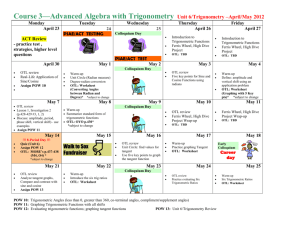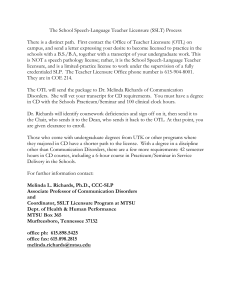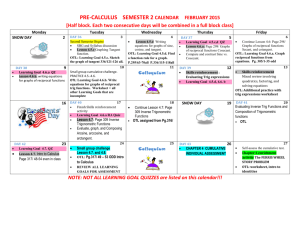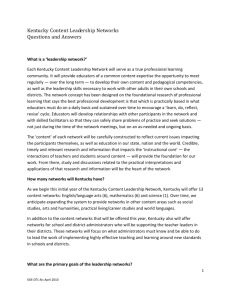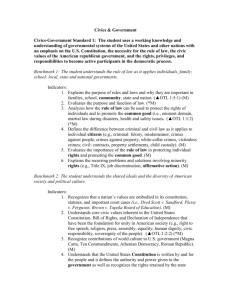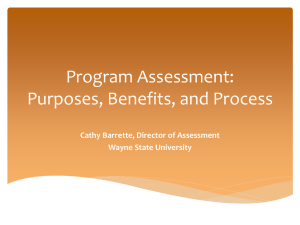Opportunity to Learn (OTL)
advertisement
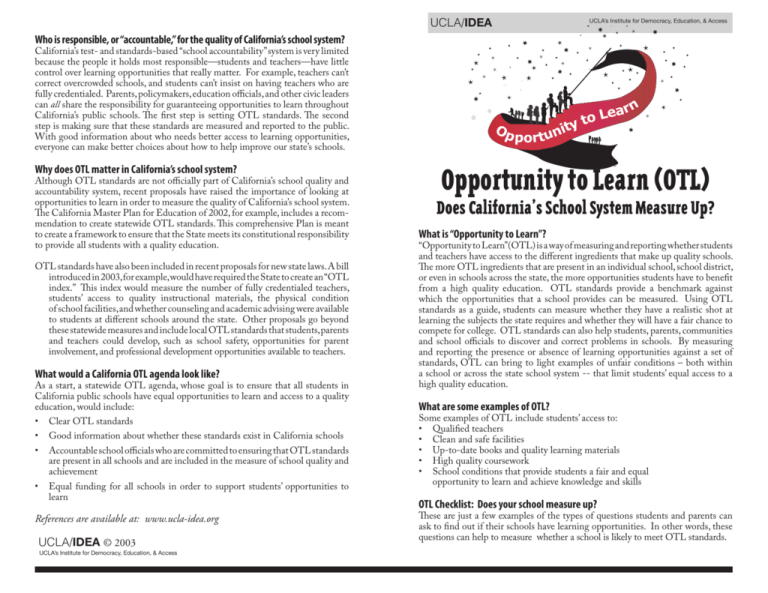
UCLA/IDEA UCLA’s Institute for Democracy, Education, & Access Who is responsible, or “accountable,” for the quality of California’s school system? California’s test- and standards-based “school accountability” system is very limited because the people it holds most responsible—students and teachers—have little control over learning opportunities that really matter. For example, teachers can’t correct overcrowded schools, and students can’t insist on having teachers who are fully credentialed. Parents, policymakers, education officials, and other civic leaders can all share the responsibility for guaranteeing opportunities to learn throughout California’s public schools. The first step is setting OTL standards. The second step is making sure that these standards are measured and reported to the public. With good information about who needs better access to learning opportunities, everyone can make better choices about how to help improve our state’s schools. Why does OTL matter in California’s school system? Although OTL standards are not officially part of California’s school quality and accountability system, recent proposals have raised the importance of looking at opportunities to learn in order to measure the quality of California’s school system. The California Master Plan for Education of 2002, for example, includes a recommendation to create statewide OTL standards. This comprehensive Plan is meant to create a framework to ensure that the State meets its constitutional responsibility to provide all students with a quality education. OTL standards have also been included in recent proposals for new state laws. A bill introduced in 2003, for example, would have required the State to create an “OTL index.” This index would measure the number of fully credentialed teachers, students’ access to quality instructional materials, the physical condition of school facilities, and whether counseling and academic advising were available to students at different schools around the state. Other proposals go beyond these statewide measures and include local OTL standards that students, parents and teachers could develop, such as school safety, opportunities for parent involvement, and professional development opportunities available to teachers. What would a California OTL agenda look like? As a start, a statewide OTL agenda, whose goal is to ensure that all students in California public schools have equal opportunities to learn and access to a quality education, would include: • Clear OTL standards • Good information about whether these standards exist in California schools • Accountable school officials who are committed to ensuring that OTL standards are present in all schools and are included in the measure of school quality and achievement • Equal funding for all schools in order to support students’ opportunities to learn References are available at: www.ucla-idea.org UCLA/IDEA © 2003 UCLA’s Institute for Democracy, Education, & Access n ea r L o t Op ity n portu Opportunity to Learn (OTL) Does California’s School System Measure Up?∑ What is “Opportunity to Learn”? “Opportunity to Learn”(OTL) is a way of measuring and reporting whether students and teachers have access to the different ingredients that make up quality schools. The more OTL ingredients that are present in an individual school, school district, or even in schools across the state, the more opportunities students have to benefit from a high quality education. OTL standards provide a benchmark against which the opportunities that a school provides can be measured. Using OTL standards as a guide, students can measure whether they have a realistic shot at learning the subjects the state requires and whether they will have a fair chance to compete for college. OTL standards can also help students, parents, communities and school officials to discover and correct problems in schools. By measuring and reporting the presence or absence of learning opportunities against a set of standards, OTL can bring to light examples of unfair conditions – both within a school or across the state school system -- that limit students’ equal access to a high quality education. What are some examples of OTL? Some examples of OTL include students’ access to: • Qualified teachers • Clean and safe facilities • Up-to-date books and quality learning materials • High quality coursework • School conditions that provide students a fair and equal opportunity to learn and achieve knowledge and skills OTL Checklist: Does your school measure up? These are just a few examples of the types of questions students and parents can ask to find out if their schools have learning opportunities. In other words, these questions can help to measure whether a school is likely to meet OTL standards. UCLA/IDEA Are students in classes where the content, or school subject, is taught? For example, if a school does not have an advanced biology class available, students can’t learn the subject of advanced biology. In other words, they do not have the “opportunity” to learn advanced biology. Do students spend enough time with the content, or subject matter, for their grade level? For example, if students are forced to learn in a class that doesn’t spend enough time on a school subject, they don’t have the opportunity to gain deep knowledge about that subject. If students are forced to learn in a year-round calendar where the school year is cut short because of school overcrowding, they have less time, or opportunity, to learn at all. UCLA’s Institute for Democracy, Education, & Access Why does OTL matter? OTL standards matter because they help to show whether a school “measures up” to quality education. In other words, OTL standards: • Tell parents, students, community members and public officials whether schools and the education system are working. • Focus attention on what education officials and other policymakers can do to improve the quality of schools, and make sure that all schools have basic opportunities in place. • Focus attention on the types of conditions in the school system, and not just on “outcomes” such as test scores. Are OTL standards equal across all schools? Do students have books and other learning materials? For example, if students are forced to use outdated books, books with missing pages, or have no books at all in their classrooms or to take home, they don’t have the opportunity to learn current knowledge. If a school doesn’t have computers available, students can’t do research on the Internet. If a school doesn’t have working laboratories or calculators, students can’t learn certain science or math subjects. No. Some schools provide students with great opportunities to learn while other schools offer very few opportunities. In other words, OTL is not equal throughout California’s school system, and many schools would have trouble meeting basic OTL standards. For example, research shows that schools with the highest numbers of Latino/a and African American students enrolled have the biggest shortages of textbooks and the lowest numbers of qualified teachers. Do teachers have the knowledge and training to be effective? How does OTL relate to test scores or other measures of school “achievement”? For example, if teachers have only “basic” knowledge or training, they can’t answer advanced questions or teach certain subjects well. This, in turn, limits students’ opportunities to learn. Do students have laboratories, hands-on projects, and activities? For example, if classes are limited to one-way lectures or workbooks, rather than any interactive teaching, students’ learning is limited. Does the school make clear its goals for high academic achievement? For example, if the school doesn’t provide college counseling, SAT prep courses, or classes that are required to apply for college, students never learn that college is possible or how to prepare for college. Are the school facilities safe, healthy, and uncrowded? For example, if classrooms are too hot, cold, or unclean, or if students are afraid or forced to take classes in packed rooms, they can’t learn well. How does OTL affect teachers? Just like students need opportunities to learn, OTL standards can show whether teachers have the working conditions to do their best job at teaching – that is, by having basic tools such as books, labs, libraries, and clean facilities. Over the past decade, efforts to improve California’s school system have been guided by a simple formula based on “curriculum” standards, test scores, and so-called “accountability.” This means that: • The education system should be very clear about what subjects students are expected to learn. In other words, they must have clear “curriculum standards.” • Students will be tested to see if they have actually learned what they are supposed to. In other words, test scores are used to see if students meet “performance standards.” • Rewards and punishments for students learning or not learning (or for receiving high or low scores on the test) will motivate teachers to find the best ways of teaching and will motivate students to study harder. • If students do not improve their test performance, they and/or their teachers will suffer consequences. In other words, students and teachers are held “accountable” for meeting the performance standards. Opportunities to Learn have not been a part of this standards-based system. As a result, it is difficult, if not impossible, to measure students’ “performance” accurately and fairly if there is no information available about whether they had a chance to learn in their schools. For a standards-based school accountability system to be accurate, useful, and fair, OTL standards must be included along with performance standards.
